2013 Polaris Indy 600 vs. 2013 Ski-Doo MXZ Sport 600

Polaris' new Indy 600 squares off against Ski-Doo's veteran MXZ Sport 600
When Polaris dropped its Fusion-based IQ chassis and suspension trail sport models in favor of the Pro-Ride RUSH, the Minnesota-based snowmobile pioneer sought to one-up Ski-Doo and its hugely successful REV chassis models. Since most anything was better than the ill-fated Fusion, Polaris had success, but not enough to truly scare marketing folks at BRP/Ski-Doo, which simply kept updating its original REV with newer and more effective ride-forward platforms, culminating in the latest REV-XS sport models.
While Ski-Doo may not have been shaking in its Sorels, the Quebec-based snowmobile maker knew that it could be a matter of time before (a) Polaris got very serious about taking back its former Number 1 sales leadership position and (b) that Polaris reapplied the strengths of the Fusion, mainly the refreshed suspension and ride forward positioning, to make a serious run at Ski-Doo. Moving into model year 2013, we see that Ski-Doo needed to be concerned. Polaris has earned back its deep snow leadership thanks to the extremely popular – and Number One selling – powerful and lightweight RMK models. While the RUSH hasn’t been the great challenge to the Ski-Doo MXZ series that Polaris had hoped, the longer tracked RUSH-based Switchback introduced last season forced Ski-Doo to revamp its Renegade and add its rMotion to more models, including the stretch-track line up.
While the RUSH enjoys key updates since its initial appearance, the Ski-Doo MXZ X and TNT series still hold their leadership and should expect to maintain that edge as the rMotion long stroke rear suspension was added to more models as standard fare for 2013. The Pro-Ride RUSH and the rMotion MXZ showcase two different ways of achieving essentially the same quality of ride. Feature for feature the two brands give the buyer very similar trail values.
But, as we move into 2013, Polaris reloads once again and confronts Ski-Doo with a redesigned and totally rebranded Indy 600. Ski-Doo holds a definitive edge in pricing, as its 2013 Ski-Doo MXZ Sport 600 will battle for buyers in the basic trail sports arena. The new world economics make US$8,000 or less the battleground for beginner sled buyers. All four sled makers have entries, but the real battle should be the Indy 600 versus the Ski-Doo MXZ.
We expect that the best battle will pit the Indy 600 SP against the MXZ TNT 600. Price may be a factor there as well, but this time it will favor the Polaris models.
In the basic 600 trail sport category, Ski-Doo’s MXZ Sport 600 clearly wins the price battle. At US$6,999 the Ski-Doo Sport will start a thousand dollars under the Polaris Indy 600’s suggested retail of US$7,999. You can purchase some nice add-ons for that difference.
Of course, the Polaris Indy 600 just as clearly wins the power battle. With its nifty fuel-injected Cleanfire twin squaring off against the older, twin carb Rotax 600, the Indy 600 will ramp up quicker and stronger than the Ski-Doo. That’s expected since there are at least 20 more ponies available at the Indy’s throttle flipper. The 2013 Polaris Liberty 599cc liquid-cooled two-stroker easily pumps out 130-ish horsepower while the Rotax powerplant is rated at 108 horsepower. In its day the slide valve TM-40 carb equipped Rotax 600 was a top-rated runner. It still is, but the advent of Ski-Doo’s own direct injection 600 E-TEC and Polaris’ latest twin semi-direct injector Cleanfire technologies render the best carburetion systems relatively obsolete.
The Polaris Indy 600 relies on a proven P85 main drive and P2 secondary drive to get power to the track. Ski-Doo finds tried and true works well for the MXZ Sport 600, which features a TRA III driver and a QRS secondary. Both sleds come with extremely adept hydraulic disc baking systems, although Ski-Doo adds a stainless steel braided brake line to its Brembo setup.
Chassis-wise you get proven platforms. If it weren’t that Ski-Doo just introduced the latest XS version of its REV design, you wouldn’t feel cheated just a bit with the fact that this 2013 Ski-Doo MXZ Sport retains the older REV-XP chassis. More than likely the XS design will spread to virtually all Ski-Doo trail sport models in coming seasons, but for now the Sport series, along with select luxury personal sport models and some Renegade models, stays with the XP design. This is pretty darn good, so don’t despair. Plus, the entire MXZ Sport 600 package weighs in at a very nimble 420-pounds versus the 27-lbs. heavier Indy.
Polaris bases its new Indy 600 model on its Pro-Ride chassis, which is engineered to be extremely light and rigid. We figure that the Indy and the MXZ Sport are quite even in chassis development. You will ride forward and strategically centered on either sled. From our view, the two sleds are amazingly similar in saddle feel. The Indy 600 features the lightweight Freestyle seat. Ski-Doo upgraded the 2013 MXZ Sport 600 with the latest and equally comfortable REV-XP seat.
On the trail, you can expect up to nine inches of front suspension travel. The Indy 600 comes with a Pro-Ride double A-arm design controlled by coil-spring assisted RydeFX MPV gas shocks, which are also used in the rear slide suspension. The Ski-Doo’s dual A-arm front end features Motion Control shocks, which are similar. Frankly, we would give the edge here to the Polaris Indy 600.
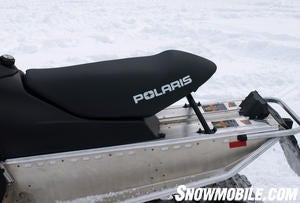 The lightweight Freestyle affords ample movement for aggressive riding or “kick back” cruising.
The lightweight Freestyle affords ample movement for aggressive riding or “kick back” cruising.
If you think of the Indy 600 as a RUSH minus the Pro-Ride RUSH rear suspension, we don’t think you’d be too far from the truth. The Indy 600, like the Ski-Doo MXZ Sport, uses a controlled action, coupled skid design. The Ski-Doo’s SC-5 rear suspension will give you a claimed maximum travel of 15-inches versus the 13.9-inches offered by the Indy rear suspension. We don’t see any big advantage between the two rides.
There are some things that we definitely like better on the Ski-Doo. For instance, the Ski-Doo handlebars are straight steel, but come with standard J-hooks to fit performance riding, especially cornering. The base Indy 600 straight handlebar is okay, but not as welcoming for spirited riding. The more expensive and upgraded Indy 600 SP, by the way, has a terrific handlebar setup with a very natural curvature. Plus, the SP version has the latest Pro-Steer ski design, which again lifts the performance bar between the two Indy 600 models.
We also like that the Ski-Doo features a RipSaw track with 1.25-inch lug height. The Indy 600 has the tamer Shockwave and 0.91-inch track profile.
While there are definitely performance highlights favoring the Indy 600, such as fuel injection and superior power, the Ski-Doo MXZ Sport makes price a definite consideration. On the trail, the Indy 600 will motor more powerfully, but the Ski-Doo will grip and grab with authority. Chassis and suspension considerations are, in our estimation, very similar. Both come with similar convenience and nice-to-have electronic reverse. Seating and onboard movement would be similar if you hopped from one to the other. The Ski-Doo has a slight advantage in handlebar feel and in helping you set up to attack corners. Plus, the on-trail traction should be better with the MXZ Sport’s RipSaw track.
Overall, what we see as the major differentiators come down to: Price or Power! Is saving a $1000 by going with the Ski-Doo worth giving up more than 20 horsepower and having carburetors versus semi-direct fuel injection? That’s really the question, because everything else is relatively the same.
| 2013 Polaris Indy 600 | 2013 Ski-Doo MXZ Sport 600 | |
| Engine | Polaris Liberty Cleanfire 599cc, twin cylinder, two-stroke liquid-cooled; Cleanfire 2 fuel injection | Rotax 597cc, two-stroke twin; liquid-cooled; 2x TM40 slide carbs; RAVE exhaust |
| Horsepower | 125+ | 108 (claimed) |
| Drive | Polaris P-85 drive; P2 driven with PERC electronic reverse | Ski-Doo/Rotax TRA VIII drive with QRS driven; RER |
| Front Suspension | Polaris Pro-Ride — 9-in maximum travel; RydeFX MPV shocks | Ski-Doo dual A-arms with spring over Motion Control shock; up to 9-in travel |
| Rear Suspension | Polaris Indy parallel rail; 13.9-inches of travel; RydeFX gas shocks on coupled suspension | Ski-Doo SC-5 parallel slide rail with Motion Control shocks; up to 15-in travel |
| Length | 114.0 in | 114.4 in |
| Width | 48.5 in | 47.9 in |
| Height | 48.0 in | 47.6 in |
| Ski Stance | 42.5 in | 42.4 in |
| Track | 15x121x0.91 Shockwave | 15x120x1.25 RipSaw |
| Weight | 447 (claimed) | 420 (claimed) |
| Brake | Polaris Phantom hydraulic | Brembo hydraulic disc with stainless steel braided brake line |
| Features | Standard: Fixed steering with 3.5-in riser; Multifunction gauge; lightweight Freestyle seat; Optional: 12v-DC outlet; varied height and/or colored windshields; handlebar hooks; storage bags | Standard: REV-XP chassis; steel handlebar with J-hooks; analog/digital gauge; Optional: electric start; rearview mirrors; storage bags |
| Fuel Capacity | 11.2 US Gal | 10.6 US Gal (87 octane fuel) |
| MSRP | $7,999 | $6,999 |
| Full Specs | Here | Here |
Related Reading
2013 Polaris 600 Indy SP Review – Video
2012 Polaris 600 Rush Review
2012 600 Trail Sports Class Roundup
2011 Ski-Doo MXZ TNT 600 ACE Review



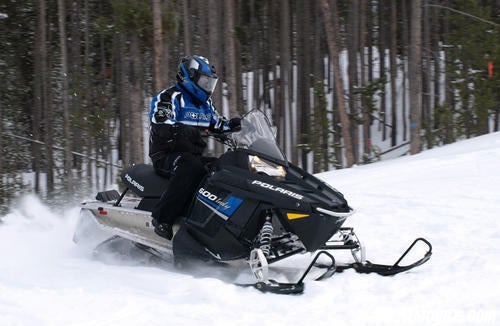
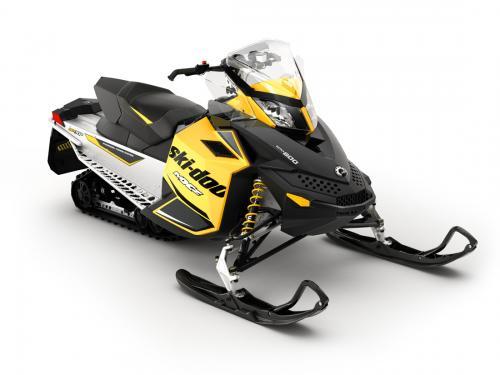
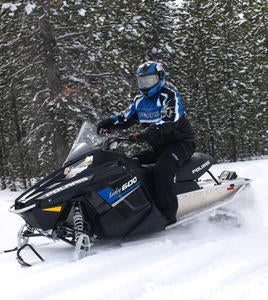
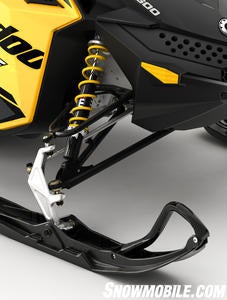
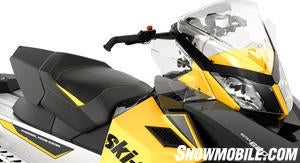





 Your Privacy Choices
Your Privacy Choices